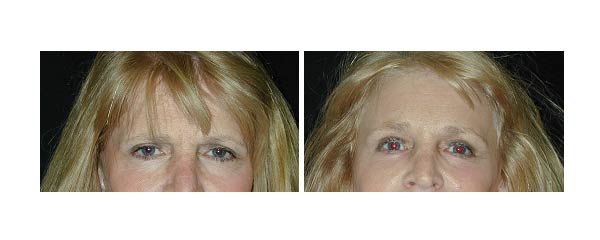What is a Brow Lift?
A forehead lift, or also known as browlift can improve low eyebrows, deep forehead creases and or deep furrows between the eyebrows (frown lines). Low eyebrows, know as eyebrow ptosis can cause excess skin hanging over the outer aspect of the eyes (hooding) that can give a tired, sad or even angry appearance. A forehead lift can improve all of these problems. It may often be performed at the same time as a facelift, which removes excess skin and tightens muscles in the mid and lower face. If there is significant skin overhang in the upper eyelids, or puffy bags beneath your eyes, eyelid surgery may be recommended in addition to a forehead lift. Dr. Mezrow will provide further information if you have an interest in these procedures.
Consulting with Dr. Mezrow:
During the consultation, Dr. Mezrow will ask you about your particular concerns regarding your upper eyelids, eyebrow and forehead region. This will help determine your expectations and determine whether they can be realistically achieved.
There are a various techniques to elevate the eyebrows, decrease deep forehead wrinkles and diminish frown lines. After obtaining a comprehensive medical and surgical history, Dr. Mezrow will examine your upper eyelids, eyebrow position, forehead wrinkles, muscle activity that causes frown lines, hair density as well as position of the hairline. Following the examination Dr. Mezrow will discuss with you which of the techniques of brow lift you are a candidate for. Dr. Mezrow will discuss with you, the risks, benefits and alternatives and answer all your questions.
How is the procedure done/Where will I have scars?
Coronal technique involves an incision that extends from the top of the ears extending across the top of the scalp. The incision is placed behind the hairline in patients with low or average hairline position or at the hairline in patients with high hairline position. Other techniques involve limited incision endoscopic or limited incision non-endoscopic surgery that utilized several smaller incisions typically positioned behind the hairline.
During the forehead lift procedure, the muscles that cause forehead wrinkling and frown lines are modified and or portions removed; the eyebrows are elevated and excess skin is sometimes removed depending on the technique utilized.
Forehead lift is usually performed as an outpatient. It is important to arrange for someone to drive you home after surgery and to stay with you for at least the next day or two. The procedure typically takes approximately 1-2 hours to perform. Most patients recover within 1 to 2 hours after surgery and are discharged home.
Check out Before and After photos of our clients
What are the potential complications?
Fortunately, significant complications from forehead lift are infrequent, however, all surgery has risks. Some potential complications include infection, bleeding, hematoma (accumulation of blood under the skin), delayed healing, asymmetries, changes in hairline position or loss of hair, altered ability to raise eyebrow and wrinkle forehead, altered forehead sensation and poor scarring. A complication, which delays healing and prolongs recovery, is more common in diabetic patients and those who smoke. Preoperative and postoperative instructions will be given to you by Dr. Mezrow in attempt to reduce the likelihood of complications and make you as comfortable as possible with the whole process. Smokers will be instructed to stop smoking 4-6 weeks prior to surgery and not resume smoking to reduce the risk of delayed healing, wounds, infections and compromised outcome. Aspirin, anti-inflammatory medications as well as agents that cause bleeding should be discontinued two weeks prior to surgery (or as otherwise instructed by Dr. Mezrow and your primary physician) to reduce the likelihood of bleeding.
What kind of medications will be given to me?
Medications are administered for your comfort during the surgical procedure. Typically, a local anesthetic, intravenous sedation or general anesthesia is administered. Depending on other procedures being performed in conjunction with forehead lift such as a face-lift usually requires a general anesthetic to be administered. When surgery is completed, you will be taken into a recovery area where you will continue to be closely monitored. You will have a gauze bandage head dressings around your head.
You may be permitted to go home after recovery, unless you and Dr. Mezrow have determined that you will require a short stay in the hospital or post surgical facility.




